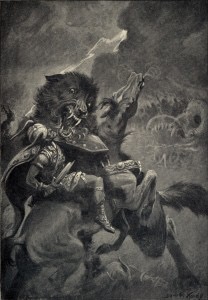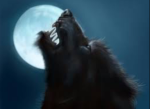“Fenrir grew at an alarming rate, however, and soon the gods decided that his stay in Asgard had to be temporary. Knowing well how much devastation he would cause if he were allowed to roam free, the gods attempted to bind him with various chains. They were able to gain the wolf’s consent by telling him that these fetters were tests of his strength, and clapping and cheering when, with each new chain they presented him, he broke free.” Source Norse Mythology for Smart People
Was Fenrir a real threat to these gods? These old world pre-Christian Norse legends are about fearing the unknown. These gods wanted to control Fenrir because of fear of the unknown.
“When the gods presented Fenrir with the curiously light and supple Gleipnir, the wolf suspected trickery and refused to be bound with it unless one of the gods would lay his or her hand in his jaws as a pledge of good faith. None of the gods agreed, knowing that this would mean the loss of a hand and the breaking of an oath. At last, the brave Tyr, for the good of all life, volunteered to fulfill the wolf’s demand. And, sure enough, when Fenrir discovered that he was unable to escape from Gleipnir, he chomped off and swallowed Tyr’s hand.” Source The Binding of Fenrir
The gods betrayed Fenrir’s good nature. In the end the wolf Fenrir’s fate was to devour all of the earth. This was set in place by gods who wanted control over Fenrir the wolf because they feared the unknown.
“As the river’s ominous name implies, this was not the end of Fenrir. At Ragnarok, he broke free and ran throughout the world with his lower jaw against the ground and his upper jaw in the sky, devouring everything in his path.[3] He even killed the god Odin before finally being put to death by one of Odin’s avenging sons.” Source The Binding of Fenrir
Fenrir proves himself to be a trickster in the end. After all, fenrir is the son of Loki. Loki was known for acting out and using tricks to deceive the other gods.
Fenrir the wolf myth is a symbol of nature that can not be managed by trickery. The Norse myth of Fenrir shows how much the Norseman respected the wolf even refering to him as the son of a god during pre-Christinan times.
The Wolf Transformed
During the time period known as The Dark Ages the wolf becomes a monster in myth and legends.
Werewolf a blood-thirsty monster.
A Werewolf is a person who changes for periods of time into a wolf, typically when there is a full moon.
In horror storries read at Holloween a wolf is portrayed howling at the moon as part man, part wolf known as a Werewolf. This image of a wolf with fangs bared howling at the moon is ficticous and should never be taken serious. Wolves are not blood-thirsty monsters howling at the full moon.
In fact, healthy wild wolves avoid humans at all cost. I have been within ten feet of a wild wolf without incident.
Science proves that wolves howl to communicate with their pack members not at the full moon.
Wolves have been the subjects of art and literature since the beginning of time.
Our fascination with wolves must reflect scientific fact not myth.
The wolf in art.
As an artist/educator, I found Earthjustce’s campaign to rebrand the image of the wolf through art is a brilliant idea.
#JoinThePack by Earthjustice’s campaign to keep wolves listed under the Endangered Species Act uses art to rebrand the image of the wolf. Click HERE to take action for wolves.

This
campaign is meant to strike a playful tone, but the threats to gray
wolves are very real. We’re excited to partner with CAN to remind people
why wolves are worth protecting and to get people howling for their
right to continue to exist. Drew Caputo Vice President of Litigation
for Lands, Wildlife and Oceans, Earthjustice
Scientific facts win out over myth & folklore everytime.
European folklore gives garlic the ability to ward off werewolves, but modern science proves garlic has several health benefits. Science has proven wild wolves are essential for healthy ecosystems. How Wolves Changed Rivers in Yellowstone National Park after being reintroduced there 20 years ago proves wolves are essential. Click HERE to view the short film How Wolves Change Rivers.
In conclusion, Fenrir wolf myth in Norse mythology reflects man’s fear of the unknown, and at the same time respects the role the wolf played in nature.
Today we find ourlseves teetering between old myths and scientific fact that threatens to undermine the Endangered Species Act.
Please take action by asking the president to #VetoExtinction. Stop the legislative attacks on the Endangered Species Act.
To contact the White House click HERE
~~~
Norse Mythology for Smart People, The Binding of Fenrir
Earthjustice #JoinThePack
source





No comments:
Post a Comment